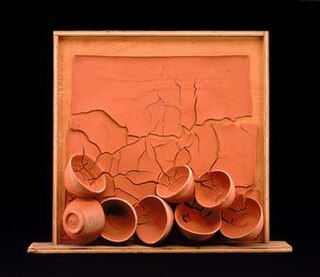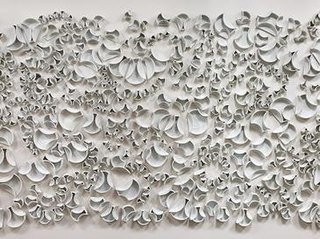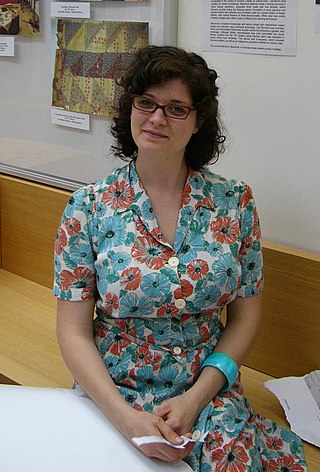Selected works
Consciousness/conscience
Between 2001 and 2004 Consciousness/conscience was exhibited in a variety of places including the Tate, Liverpool; Crafts Council, London; and Icheon, Korea. At each of the sites of installation, between 3000 and 8000 hollow bone china tiles were created to be displayed on the floor. As the viewer walked through the installation, the tiles were crushed underfoot, causing the viewer to be an active participant in shaping the work and challenging the viewer's perception of both the gallery space and the permanence of the work. [6] The artwork was thus completed through the destruction of the tiles. [7] Consciousness/Conscience has been interpreted as showing how the artist's work is "influenced by observations of human interaction and political behavior and peruses her interest in space, architecture, intervention and the gallery as destination." [8]
Trophy
In 2006 Trophy was exhibited at the Victorian and Albert Museum. This one-day exhibition displayed 4000 sculptures of cast bluebirds that were created at the Wedgwood Factory. Each bluebird was stamped with a W for where it was made, V&A for where it would be exhibited, and CT for the artist's initials. Viewers became collaborative performers when they were asked to take one of the birds home as a 'Trophy.' These active participants who took these trophies were asked to send a photograph back to Twomey of the birds in their new home. "Trophy continues to develop as is spreads out across hundreds of private locations" [9]
Monument

In 2009, Clare Twomey created the work Monument for the Middlesbrough Institute of Modern Art as part of the exhibition Possibilities and Losses: Transitions in Clay, which she helped to curate. [10] [11] This exhibition included Keith Harrison, Linda Sormin and Neil Brownsword. For Monument, 30 cubic meters of ceramic waste were piled up 8 meters high. [12] Inspired by looking at a pile of broken china from the Johnson Porcelain Tile Factory in Stoke-on-Trent, this piece was made up of discarded seconds and manufacturing mistakes. [13] The scale of the pile created tension in the work because the pile seemed as though it could crumble at any moment. [10]
Forever
In Twomey's first solo American show (2011), Twomey observed the Frank and Harriet Burnlaps collection of 1,345 pieces of ceramics at the Nelson Atkins Museum of Art. In this exhibition she explored permanence, responsibility, memory, desirability, the value and process of making through looking at one specific item from the collection, a sandbach cup. [14] Twomey worked with the ceramic company, Hartley Greens and Co. Leeds Pottery to cast 1,345 cups. Working from a similar conceptual framework as Trophy, Twomey created a system where viewers could apply to own a cup if they signed a contract promising to take care of the cup forever. [3]
Collecting the Edges
In 2011 Twomey created a museum wide installation at the Denver Art Museum in conjunction with Overthrown, Clay without Limits. This group show included artists such as Annabeth Rosen, Kristen Morgin, Jeanne Quinn, Walter McConnell, Heather Mae Ericsson, and Kim Dickey as well as many others. Collecting the Edges brought attention to the museum's architecture by creating a visual intervention which highlighted corners, ceilings and other spaces in the museum. Collecting the Edges piled red, powdered, Colorado clay into these specific spaces spreading the exhibition throughout the whole museum. In an interview in Ceramics Now, Twomey stated "When visiting a site, one must arrive with a very open mind, I had our first visit with no planned ideas for the work. I made a response to the architecture experienced, and this was vastly influential with the development of the concept." She then goes on to state that she sees this piece as "A reminder of a moment in time, rather than a demand." [15]
Humanity is in Our Hands
For Humanity In Our Hands, Clare Twomey, along with many other artists worked with the Keep the Memory Alive project, whose mission is to pair survivors of genocide with artists to bring their stories to life for the next generation. Twomey was paired with Siskc Jakupovic, who survived the Omarska Concentration Camp in the Bosnian War. In one of their exchanges Jakupovic shared a story about how in the concentration camp, they carved spoons for each other out of wood and shards of broken glass. From this story, and with the analogy that spoons can nurture and feed each other, Twomey created her piece Humanity is in our Hands.[ citation needed ]
On 27 January 2015, Holocaust Remembrance Day, Twomey distributed invitations to people walking over Westminster Bridge. "Today you are invited to be part of a new work, your words will be placed on thousands of beautiful porcelain objects that will be made in the coming year. These objects will be handed back to the public as gifts on Westminster Bridge, on this date one year from now, 27th of January 2016. The recipients will become custodians of your thoughts." [16] The question she asked the pedestrians walking over the bridge was 'What human qualities allow society of flourish?' Over the next year Twomey created 2000 porcelain spoons with the answers she received. The following year, on 27 January 2016, she gave the spoons back to the pedestrians on the bridge.











